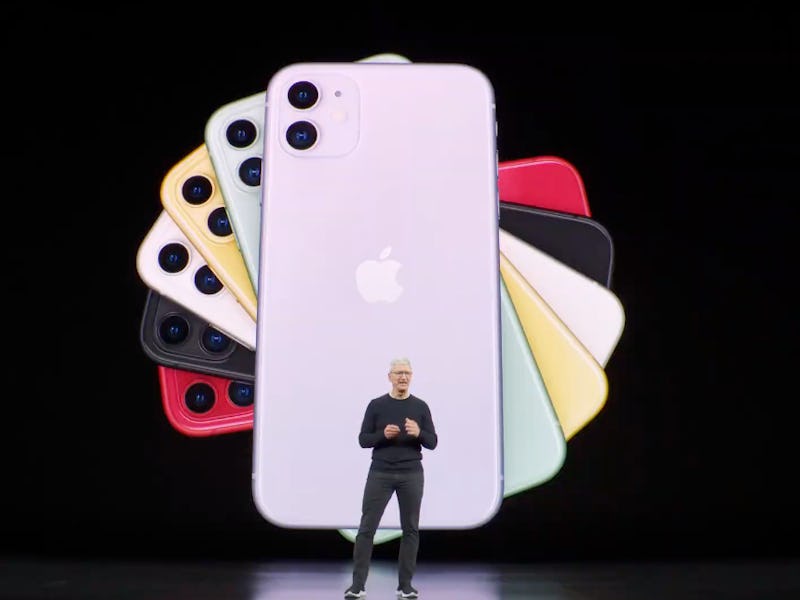iPhone 11 Launches With Dual 4K Cameras, Lower Price and A13 Chip
Apple's new phone is here.

The iPhone 11 has arrived. Apple’s next-generation smartphone launched Tuesday to great fanfare, offering a much-improved camera, an even faster processor, and even lower price.
The phone, the successor to the 2018 iPhone XR, improves on its predecessor in a number of ways. It adds a second, wide-angle camera lens alongside the original single lens. It offers the A13 Bionic chip, billed by the company as the fastest CPU and GPU in a smartphone. It also comes in at $699, $50 cheaper than the $749 iPhone XR.
"It is jam-packed with great new capabilities and an incredible new design.
“iPhone 11 [is] the next generation of iPhone, and it is jam-packed with great new capabilities and an incredible new design,” Apple CEO Tim Cook told the audience at the Steve Jobs Theater in Cupertino, California on Tuesday. The building forms part of the new Apple Park campus, one of the last projects Steve Jobs worked on at the company.
The front of the iPhone 11.
iPhone 11: Features Coming to the New iPhone
The iPhone comes in six colors: purple, white, yellow, green, black, and (Red). It has a 6.1-inch LCD screen, paired with a spatial audio system that delivers what the company calls an “immersive theater-like experience.” The anodized aluminum is paired with new, tougher glass that the company claims is the toughest ever on a smartphone.
The camera lenses, milled from a single piece of glass, enable seamless switching between regular and wide-angle shots in both photos and videos. The regular camera is a 26 millimeter f/1.8 camera with a six-element lens, optical image stabilization and 100 percent focus pixels. The other is an ultra-wide camera with a 13 millimeter f/2.4 camera with a five-element lens and a 120-degree field of view. Both cameras offer 12 megapixels.
The in-phone processing enables multi-scale tone mapping to make colors pop with greater detail. A new portrait lighting mode enables high-key mono lighting. Night Mode, another new addition, automatically enables brighter pictures that could help the iPhone take on the Google Pixel.
Regular versus night mode.
On the video side, the device can capture 4K resolution video at 60 frames per second, offering extended dynamic range on both cameras. On the front camera, slow motion video is now possible. Apple has dubbed the videos produced by the latter feature “slofies.”
The ultra-wide camera.
Beyond the camera features, the iPhone 11 is also water-resistant up to two meters for 30 minutes. It supports faster gigabit-class LTE connections and Wi-Fi 6, but no 5G. It offers one hour more battery life than its predecessor, the iPhone XR that was previously billed as the iPhone with the longest battery life. The new device is $50 cheaper than its predecessor, at $699.
iPhone 11: Why the Lack of Changes?
So why the few changes? Apple’s new device makes some welcome additions, but on the whole bears strong similarities to the iPhone XR. It has the same 6.1-inch LCD screen, suggesting it could feel very similar to the older device.
From the iPhone 3G in 2008 to the iPhone 5S 2013, Apple phones followed a “tick-tock” pattern, where a big redesign in one year’s lineup would be followed by a smaller, internals-focused release the next year. Think how the 3G was replaced by the 3GS, the 4 by the 4S, and the 5 by the 5S.
From the iPhone 6 onwards, Apple seems to have switched to a slower “tick-tick-tock” pattern. The iPhone 6, 6S and 7 all kept the same basic design for three years. The iPhone X in 2017 was the first phone in three years to shift the design, switching to a button-free front and face recognition, a setup largely retained for the iPhone XS.
Why the slowdown? One possibility is that people upgrade phones less. A Kantar study in 2017 found the average American consumer held onto their phone for 20.5 months in 2013 before upgrading. But by 2016, this had extended to 22.7 months, just shy of two years. The trend was also observed in China and five European Union countries.
Apple's full line of in-production iPhones and their prices, as revealed on Tuesday, September 10, 2019.
The iPhone has also taken a less prominent role in the company’s earnings. In the firm’s most recent quarterly report, iPhone revenue fell below 50 percent of the company’s total for the first time since 2012. After a high of 231 million units sold in 2015, annual iPhone sales have been bobbing around the 215 million mark ever since.
The iPhone 11: it’s part of a big new strategy, but will it work?